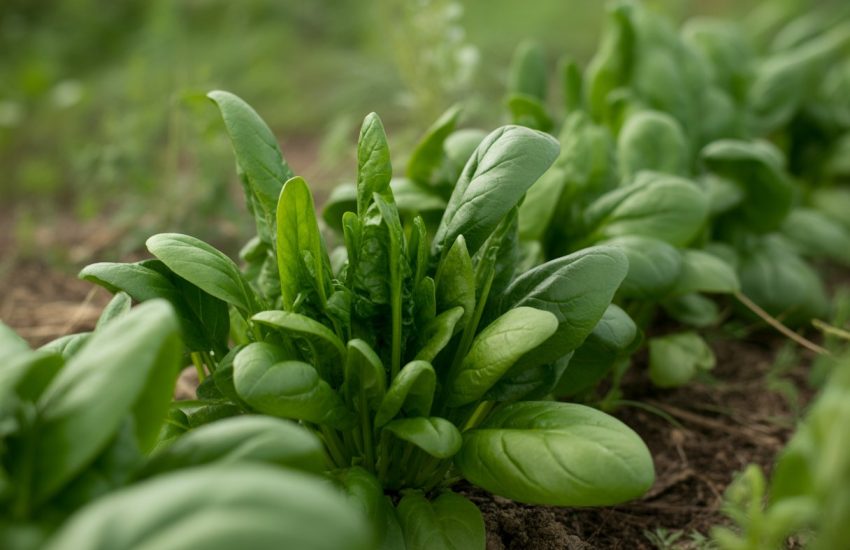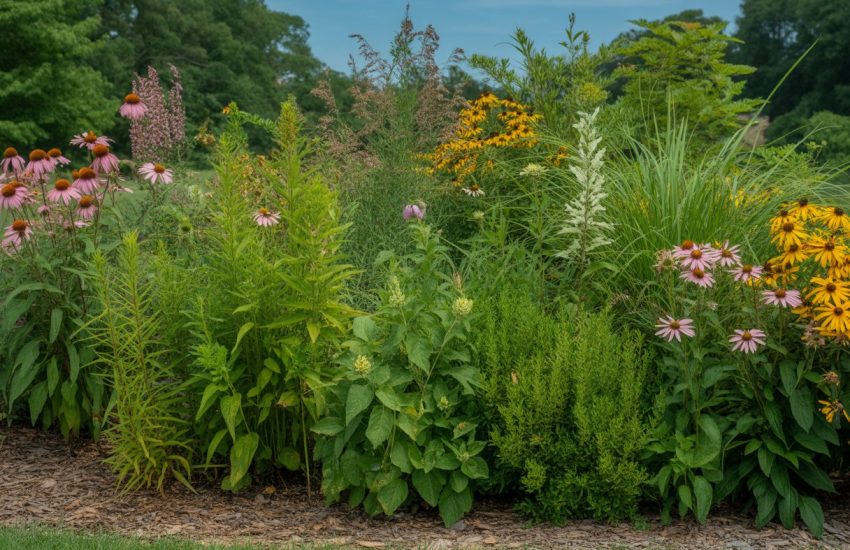Oregon Native Pollinator Plants
Are you looking for a diverse array of flowering plants for your Oregon pollinator garden? We’ve got 30 pollinator favorites that are sure to thrive in the Pacific Northwest.
Flowering plants are indispensable to pollinators and other insects. Those that produce fruits and seeds are even more valuable to native wildlife. There are many important considerations that you need to make when planning a pollinator garden. Here are five tips that will set you in the right direction:
Avoid Pesticides:
Pesticides and other landscaping chemicals have the potential to harm and even kill precious pollinators. Always opt for organic means of pest prevention. Propagate pest-resistant companion plants.
Embrace Variety:
Your pollinator garden should be able to sustain insects and other guests for several months out of the year. Plant flowers that bloom in spring, summer, and fall. This way, your pollinating guests will never go home hungry.
Soak Up the Sun:
Pollinators typically feed in the sun. Plant flowers that can appreciate the heat. Make the most of drought-tolerant varieties.
Choose Enduring Varieties:
Choose plants with long-lasting blossoms. Flowers that last for several weeks or months are more likely to sustain pollinator populations. Map out your garden so that you have something blooming at all times.
Find Safety in Numbers:
Flowering plants should always be planted in groups. Choose plants of varying sizes and colors. Make sure that there is something for everyone, including pollinators that only come out at night. Make sure to include flowers with a wide variety of colors, shapes, and aromas.
Top 30 Plants for Oregon Pollinator Gardens
Lovage (Levisticum officinale)
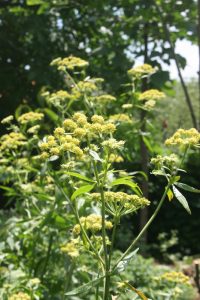
This mid-late bloomer produces an abundance of yellow blossoms. This fast-growing plant can grow 3 to 6 feet tall and 2 to 3 feet wide. Its stems and leaves are often used as herbs. They have a celery-like flavor that compliments many dishes. Lovage also produces thick, sticky nectar that’s loved by bees and other native pollinators. Plus, it returns year after year with little to no coaxing.
Monch Frikart’s Aster (Aster x frikartii)
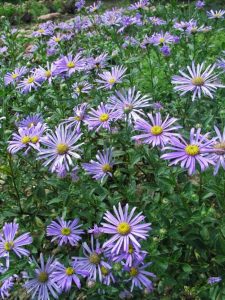
This late-blooming flower feeds all sorts of pollinators. The yolk-like centers of these deep blue blooms are easy targets for bees and other pollinating insects. We’re talking about a plant that is mildew-, deer-, and rabbit-resistant. Monch Frikart’s Aster is even one to survive droughts and other extreme weather.
It’s also one of only a handful of plants that provide nectar well into the fall.
Michaelmas Daisy (Aster amellus)
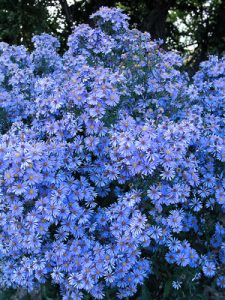
The Michaelmas daisy is another late-bloomer that is capable of attracting a wide variety of insects. This lovely perennial produces light blue, white, purple, and pink flowers, all of which feature spiky yellow centers and soft tooth-shaped petals.
Michaelmas Daisy grows well in hardiness zones three through nine. The plant produces a large number of flowers that last from late August through October. Its late-season blooms make it an obvious addition to any well-rounded pollinator garden.
This hearty plant is one of our go-to recommendations for small spaces. After all, it fares well in containers, window boxes, and landscape borders.
Lacy Phacelia (Phacelia tanacetifolia)
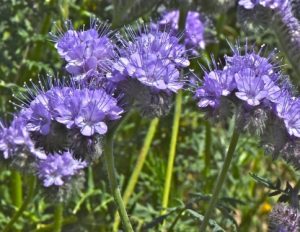
Lacy phacelia, or blue tansy, and other members of the borage family produce flowers that are beloved by Oregonian pollinators. This plant produces tall curved stems with a small number of shoots. Spiky flower clusters adorn the tips. The flowers typically last from late spring to July.
Lacy phacelia is native to several Southwest states and parts of northwest Mexico. However, it is also a popular cover crop in parts of the Pacific Northwest. It can tolerate temperatures as low as 10 degrees Fahrenheit and will likely return even after a long, cold winter.
Showy Tarweed (Madia elegans)
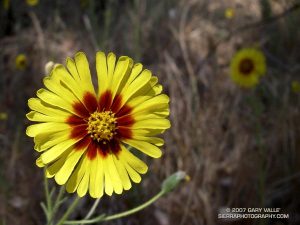
This sunflower-like wildflower can be found in the wild from Washington to Southern California. Each stalk produces multiple flower heads. The blooms tend to be bright yellow with burnt orange or purple centers. Bees and other pollinators love nestling under the plant’s protective foliage. The disc-shaped flowers make excellent landing pads for moths and other delicate creatures.
Showy tarweed blooms in late summer. Its short-lived but well-loved late-season flowers precede a bounty of seeds. These abundant achenes become food for birds, chipmunks, and other wild animals.
These impressive flowers can grow to be as tall as 5 feet. Scatter seeds in a grassy spot that receives plenty of sunlight, and you should have no trouble getting your tarweed to bloom. Mature tarweed plants have a fruity aroma.
California Poppy (Eschscholzia californica)
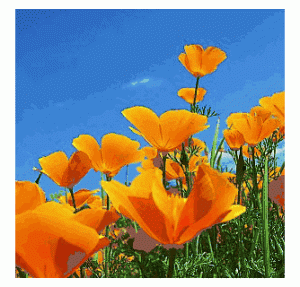
The California poppy is a self-seeding annual with feathery green leaves and soft orange flowers. This lovely flower is native to California and Oregon. It typically grows in grassy fields and other open areas. The plant does best when it is paired with other native wildflowers, including lupines and globe gilia.
California poppy is a host plant to the acmon blue, veined blue, Mormon metalmark, and Pacific dotted blue butterflies. The plant’s other regular visitors include glistening beetles, pirate bugs, syrphid flies, bumblebees, sweat bees, and mining bees. While California poppies do not produce nectar, they are a viable source of pollen.
Mint (Mentha species)
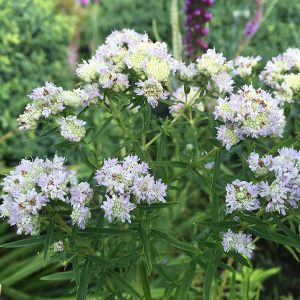
Both mint and spearmint do well in Oregon. Popular species include apple, chewing gum, chocolate, ginger, Kentucky colonel, mojito, and Moroccan mint. Keep in mind that there are over 600 varieties of mint on the planet. Your sure to find a tasty variety that will fare well in your garden.
Mint is a perennial herb that spreads very efficiently. It may produce white, purple, or pink flowers, all of which are beloved by a wide range of pollinators. These plants and their blooms reappear every year. Once established, they require very little maintenance. Plant your mint in containers if you do not want it to spread. This ambitious plant can grow as much as 2 feet in six months.
Mint provides nectar and pollen for bees and other pollinators. Some varieties even serve as host plants for moth larvae. Mountain mint is a host plant for crocus geometer and hermit sphinx moths.
Chokecherry (Prunus virginiana)

Chokecherry is a deciduous shrub that is native to various parts of North America. The bushy plant produces long branches, dark green leaves, white flower clusters, and dangling red berries. The five-petaled flowers bloom in spring. Meanwhile, the fruits appear in late summer or fall.
Choose between red and black chokeberry varieties. Both do well in temperate climates. They both produce nectar and pollen. Each plant is capable of feeding hundreds of bees, butterflies, and ants.
California Lilac (Ceanothus species)
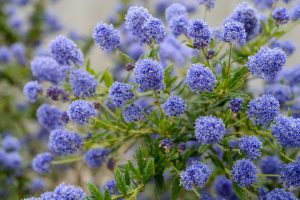
California lilac is a flowering shrub that’s native to the Western United States. It produces pale blue flowers and shiny green leaves. The flowers bloom continuously throughout summer and fall. The flowers can last up to six weeks.
The California lilac can grow to be 5 feet tall and 2 feet wide. These plants require very little maintenance and infrequent watering. The flowering shrubs can be propagated from cuttings. Keep in mind that it can several weeks for a newly planted limb to sprout roots. If you’re looking to generate blooms within the first season, we recommend that you purchase a moderately mature plant from your local nursery.
Small Camas (Camassia quamash)
Camas is a perennial herb that’s native to western North America. This plant produces small violet blooms and grass-like foliage.
It’s a popular addition to flower beds and landscape borders. We’ve also seen it included in prairie and wildflower seed mixes. Plant your camas alongside a variety of mid- and late-summer flowers. The camas’s violet buds arrive in late April and are gone by July.
The flowery plants produce edible bulbs. They were once one of the most traded food staples in the United States. Their flowers attract all sorts of bees, beetles, and ladybugs. Their open and outstretched petals make them excellent landing spots.
Prairie Sage (Artemisia ludoviciana)
Prairie sage is a wind-pollinated plant that’s very important to native pollinators. It’s a host plant for the American Lady and American {Painted Lady butterflies. It grows naturally throughout Oregon and Pacific Northwest states.
The plant produces small yellow flowers and silvery green foliage. This sage is not to be confused with the type used in food or incents. It has a lovely aroma. However, it is toxic when consumed in large quantities.
Russian sage (Perovskia atriplicifolia) is a similarly fragrant perennial. This hearty varietal produces spiky clusters of lavender flowers that are beloved by pollinators big and small. Russian sage requires good drainage and moderate shade. It can be used as a groundcover or ornamental border.
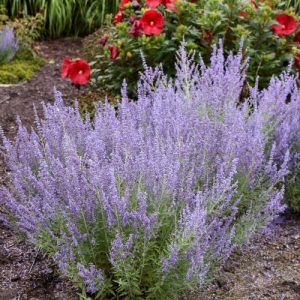
Oregon’s agricultural extension suggests that gardeners add this plant to their Oregon-based pollinator gardens. Its fragrant nectar attracts honeybees, carpenter bees, leafcutting bees, and hummingbirds.
Onion (Allium species)
Alliums, aka onions, produce flowers that require cross-pollination. They also happen to be a favorite of honeybees.
These hardy perennials grow in hardiness zones four through nine. Their stems can grow to be anywhere from 1 to 2 feet in height. The globe-shaped flowers are usually pink or purple. The blooms normally appear in mid- to late summer. Most varieties stay in bloom for anywhere from two to four weeks.
Mexican Sunflower (Tithonia rotundiflora)
These daisy-like orange blooms pop onto the Orgeon garden scene sometime during midsummer. They’re a huge draw for bees, monarchs, and other beneficial pollinators. A few of the plant’s regular visitors include hummingbirds, easter tiger swallowtails, skippers, and eight-spotted forester moths. These plants typically grow to be 4 to 6 feet tall. The flowers measure 2 to 3 inches in diameter and boast bright yellow centers surrounded by large orange petals.
Common varieties include fiesta de sol and torch. Annuals like the Mexican sunflower need to be replanted each year. Gather seeds from your mature plant. This way, you won’t have to purchase new ones in the future.
Oregon Lupine (Lupinus oreganus)
Lupine is a perennial flower that’s native to the Western United States. The coned-shaped blooms are quite popular with all sorts of native pollinators. Busy insects have no trouble making their way up these conical flowers. The plant’s clustered blooms make for easy cross-pollination.
Lupines bloom from late April to early July. They typically stay in bloom for four weeks. Wild lupines are typically purple. However, cultivated varieties come in a variety of colors.
Hyssop (Hyssopus)
This flowering shrub is native to southern Europe and Western Asia. That hasn’t stopped the U.S. Department of Agriculture from recommending it as a plant for Oregon-based pollinators. The hyssop blooms between the middle and end of summer. Its fuzzy blossoms can last for as many as three months.
Cultivated hyssops are available in white, purple, blue, red, and pink. Popular varieties include black adder, blue boa, blue fortune, kudos ambrosia, and kodus coral.
Many people consider hyssop to be an ornamental plant. This herb is also known to have medical and culinary uses.
Globe gilia (Gilia capitata)
Glove gilia is one of the most stunning wildflowers to make this list. It’s native to the Western United States and Canada and grows freely from British Columbia to Southern California. It’s an easy-to-grow annual that loves direct sunlight and well-draining soil.
The Globe gilia’s light blue blooms make their appearance in late spring or early summer. The blossoms usually last from May to June. The glove-shaped flowerheads are the perfect surfaces for foraging pollinators. The plant provides ample amounts of sweet nectar and pollen. Typical plant visitors include bees and hummingbirds. It’s also a host plant for fairy longhorn moth larvae.
Catmint (Nepeta x faassenii)
Catmint is an herbaceous perennial that grows in dense clumps. It’s a drought-resistant plant that requires very little maintenance. Its gray-green leaves and purple flowers attract all sorts of insects. Plant it in your garden to attract native bees and honeybees.
Globe Thistle (Echinops species)
Globe thistle is a stunning perennial with spherical blue flowers that tend to attract lots of pollinators. The plant’s large buds make excellent resting spots. The impressive flowers also produce ample amounts of pollen and nectar.
These lovely flowers tend to appear in early summer. The blooms can last for as long as eight weeks. Once established, these plants require very little care. They can be cultivated from seed or root cutting.
Tall Oregon Grape
Tall Oregon grape is another native plant that’s incredibly attractive to the state’s long list of native pollinators. The shrub-like plant produces shiny green leaves and fragrant yellow flowers. Once its blossoms have been cross-pollinated, it enters into its berry-making stage.
Globe thistle’s V.I.P. lounge is populated by mason bees, mining bees, and bumble bees. Hummingbirds, moths, and butterflies are also big fans of these globe-shaped flowers.
Oregon Stonecrop (Sedum oreganum)
Stonecrop is a plant that’s native to the eastern United States. However, there is one variety of the plant that can be traced back to the Pacific Northwest. Oregon stonecrop is a low-lying evergreen with bright yellow flowers. The star-shaped blossoms emerge once in summer and once in fall. They’re a welcome site for butterflies and other hungry pollinators.
Western Serviceberry (Amelanchier alnifolia spp.)
Western Serviceberry is a woody shrub with white flowers and blue berries. This bushy plant attracts all sorts of butterflies and hummingbirds. The plant is even considered a host for butterfly larvae. Its flowers bloom in late spring and last just a few days.
This plant is partially self-fertile. As such, it does not need to be planted in pairs. After the flowers wilt, the plant sprouts edible blue fruits. These serve as sustenance for birds and other wild creatures.
Purple Toadflax (Linaria purpurea)
Purple toadflax can be found in California, Oregon, Washington, and British Columbia. The seemingly native plant can be traced back to Italy. It’s an herbaceous perennial with long stems, blue-green leaves, and purple flowers. The snap dragon-like blooms are known to attract butterflies, moths, bees, and other pollinators. The flowers bloom from late spring through summer.
These lovely flowers make excellent additions to borders and pots. They can also be cultivated in meadows and other grassy areas.
Goldenrod (Solidago)
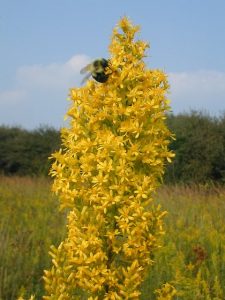
Goldenrod is a late bloomer that will attract a slew of native bees to your property. Pollinating insects adore this plant’s feather-like yellow flowers.
Goldenrod plants are capable of producing flowers from July to October. Their blossoms are chock-full of pollen and nectar.
Many gardeners still consider goldenrod to be a weed. However, you should think twice before uprooting this valuable perennial. It grows quickly and does not require much assistance. It is sure to provide many bees, moths, and butterflies with the nutrients they need to keep going.
Rue (Ruta graveolens)
Rue is a beloved member of the buttercup family. Several types of rue are native to the United States. Two popular varieties include fewflower and early meadow.
This herbaceous plant attracts everything from small bees to large butterflies.
Crabapple (Malus floribunda)
A crabapple tree will bring lots of life to your yard. These deciduous trees produce wide, rounded canopies with masses of red buds and hundreds of pink blossoms. The plant’s astounding flower clusters appear in mid-spring. The flowers lose their pink hue in a matter of days. The tree’s fruit reaches maturity in late summer or early fall.
Crabapple’s intense aroma and gooey nectar attract all sorts of pollinators. Without cross-pollination, these trees aren’t able to produce fruit. That makes it a win-win situation for the tree and its guests.
Crabapple trees should be planted in places with good drainage and lots of direct sunlight. Once these trees are established, they tend to be disease- and drought-resistant. It usually takes two to three years for a newly planted tree to produce fruit. However, a tree’s color-changing flowers and foliage should be present from the start.
Popular crabapple varieties include Japanese, purple prince, Louisa, and prairiefire.
Geraniums (Pelargonium graveolens)
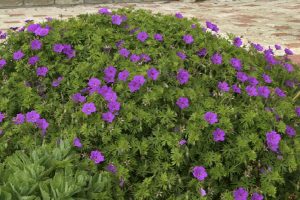
Geraniums are herbaceous perennials that do well in Oregon and the greater Pacific Northwest. These plants produce flowers all summer long. Guest pollinators tend to be well-fed and content.
There are several popular varieties of geraniums, including Oregon geraniums, Johnson’s blue geraniums, zonal geraniums, and regal geraniums. The gentle-looking flowers come in a wide variety of colors, including purplish-blue, red, pink, and white.
Geraniums can be planted in beds, containers, and hanging baskets.
Sea Holly (Eryngium species)
Sea holly is a deer- and rabbit-resistant perennial that’s native to North America. The low-maintenance plant boasts large clumps of dark green foliage and prickly blue and white flowers. It stays in bloom from midsummer to autumn.
Sea holly is easy to grow and typically flowers within a year of planting. If you’re planting during spring, you’ll want to start with a semi-mature nursey plant. Direct sow your seeds in late fall. If planting goes well, your sea holly should thrive for years to come.
Many people succumb to the temptation to put these flowers in cut arrangements. Sea holly’s real place to shine is in the garden. It’s here that they’ll serve as a source of nourishment and resting spots for bees, butterflies, and hummingbirds.
Willow (Salix species)
Several willow varieties are native to the Pacific Northwest. These include the Clatsop hooker willow, the Multnomah Columbia River willow, Nehalem Pacific willow, Placer erect willow, Plumas Sitka willow, and rogue arroyo willow.
Bees and other pollinators depend on willow buds. It’s one of their key springtime food sources. A willow tree is an excellent addition to any Oregon landscape or pollinator garden.
The willow plant produces long tube-shaped flower clusters called catkins. These ornamental trees typically flower between April and August. The flowers fade as willow leaves emerge. The flowers’ brief yet early presence makes them a vital source of nectar for early pollinators.
Douglas Aster (Symphyotrichum subspicatum)
Douglas asters are beautiful flowers that bloom in late summer. Butterflies and bees love their late-season nectar. Meanwhile, moth caterpillars, lace bugs, and other insects use plant’s leaves and stems for shelter. Birds and other small animals can also benefit from this plant’s presence in your garden. In fact, birds eat the plant’s seeds and use its foliage for shelter.
Douglas asters grow well in areas with full and partial sun. They prefer rich, fertile soil and appreciate regular waterings. They spread via underground rhizome.
Douglas asters are wildflowers that are native to Oregon. They can be observed in forests and fields from California to Alaska. They’re also easy to cultivate and maintain.
Oregano (Origanum vulgare)
Bees love the abundant nectar offered by oregano flowers. Scientists have even studied the plant to see if bees and hive products can benefit from its medicinal properties. Keep in mind that oregano is a fast-spreading perennial. You can make the plant bushier by trimming it regularly.
Oregano de la Sierra is one variety of the herb that does well in Oregon. It’s a mild herb that resembles bergamot. This aromatic plant is often used in culinary applications. Just be wary of its nectar-loving guests when you attempt to harvest it.
Do your part to support the world’s most essential inhabitants. Between 75% and 95% of the world’s crops depend on pollinators. These insects and birds play a vital role in Oregon’s agriculture and wildlife. Now, what plants are you planning on adding to your pollinator garden?

